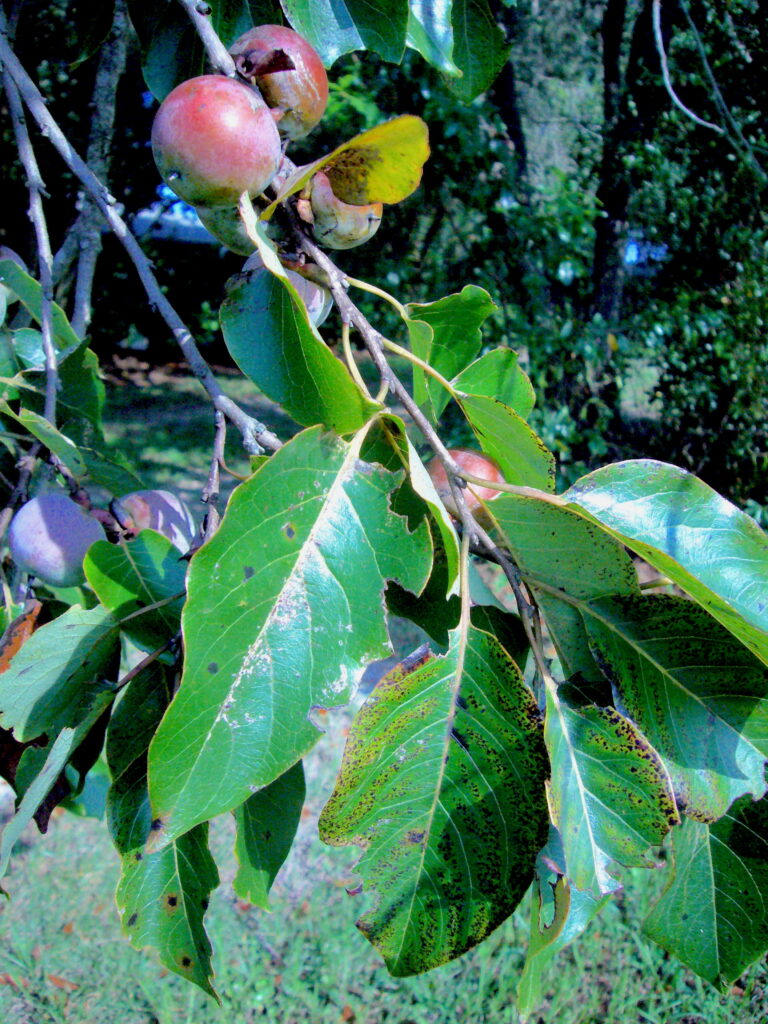
Persimmon leaves are ultra high in vitamin C. Photo by Green Deane.
It is the bountiful time of year. This past week, we ate ripe persimmons, creeping cucumbers, winged yams, drying sea grapes, purslane, cocoaplums, sugar berries, fire bush, wild coffee, yellow pond lilies, podocarpus arils, ringless honey mushrooms, milk caps, and a couple controversial Armatillo (solanum diphyllum)
The star right now is persimmons. Locally they can ripen as early as late August, as late as January though October is prime time. Usually the best ones are on the ground but as the end of the season approaches, sweet non-astringent fruit can be found on the trees. The ringless honey mushrooms are pushing the season, locally they are a common sight the second week in November. (Just remember to first eat just one cooked as a test, not all digestive systems like them.)
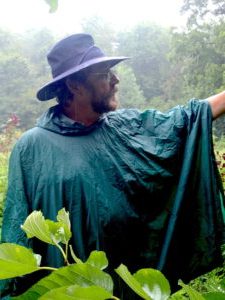
Classes are held rain or shine (but not during hurricanes.)
Foraging Classes: rain become less of an issue for classes as we move into fall, but cooler weather makes itself known.
Oct 21 Bayshore Live Oak Park, Port Charlotte, 9 a.m., meet at the parking lot at Byshore Drive and ganyard Street.
Oct 22nd Mead Garden: 1500 S. Denning Dr., Winter Park, FL 32789. Meet at the bathrooms, 9 a.m.
Oct 28th, Seminole Wekiva Trail, Sanlando Park, 401 West Highland St. Altamonte Springs, Florida 32714. 9 a.m., meet at first parking lot on right.
Oct 29th Blanchard Park, 2451 Dean Rd, Union Park, FL 32817 9.a.m. met at the pavilion by the tennis courts
To read more about the classes, to pre-pay or sign up, go here.

Nustoc is an uncommon find.
Besides the Armatillo, another controversial discussion this week involved nustoc. It is best describe as large green algae one finds in fields or the like, often dried. It can contain a lot of potential cyanide. About the only way to tell if your nustoc is edible is that people locally have been eating it for centuries, as is the case in China and Peru. It is part of some famous Asian cuisine, and is sold commercially. I’ve never had the courage to eat the species I’ve found locally. Worse, scientists think not all of the potential forms of the cyanide is known, thus lab testing won’t prove a species is edible. It’s a case for now of look but don’t eat.
In the old cartoon series BC, Wiley, a peg-legged curmudgeon, was the strip’s philosopher. One day he opined: “The bravest man I ever saw was the first one who ate an oyster raw.” He could have easily penned “who ate nostoc raw.”
Nostoc can resemble a pile of disintegrating dog scat. Not exactly appetizing. If you add that there are some 300 hard-to-identify species Nustoc barely creeps into the realm of edible. As one might presume in parts of the world where there are billions to feed they eat it. Perhaps the easiest place to find locally it is on the ground cover one walks on in nurseries. Apparently it is the cause of much slipping and falls. In the wild I see it now and then in high and dry ground with much water nearby and moisture in the air. It is particularly common near Haul Over Canal on the northwest scrubby side.
Nostoc was a mystery for centuries as folks thought it was alien and was seen after a variety of celestial events. We now know it is an algae plumped up by passing rain. Some flies like to lay eggs in it, apparently with bad effects. An article in the 2008 Journal of Ethnopharmacology reported in the Peruvian highlands Nostoc commune, when eaten as food, can produce the neurotoxic amino acid BMMA. From the Abstract:
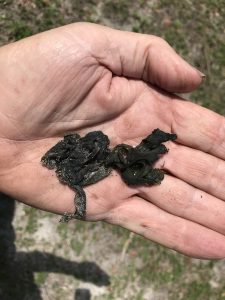
Is Nostoc a no-no? Photo by Green Deane
“In the mountains of Peru, globular colonies of Nostoc commune (Nostocales) are collected in the highland lakes by the indigenous people, who call them llullucha. They are consumed locally, traded for maize, or sold, eventually entering the folk markets of Cusco and other neighboring cities. Throughout highland Peru, Nostoc commune is highly salient as a seasonal dietary item, being eaten alone, or in picante — a local stew — and is said to be highly nutritious. Nostoc commune has been known to produce unusual amino acids, including those of the mycosporine group, which possibly function to prevent UV damage. We analyzed 21 different Nostoc commune spherical colonies from 7 different market collections in the Cusco area for the presence of beta-N-methylamino-L-alanine (BMAA), a neurotoxic amino acid produced by diverse taxa of cyanobacteria, using four different analytical techniques (HPLC-FD, UPLC-UV, UPLC/MS, LC/MS/MS). We found using all four techniques that BMAA was present in the samples purchased in the Peruvian markets. Since BMAA has been putatively linked to neurodegenerative illness, it would be of interest to know if the occurrence of ALS, Alzheimer’s, or Parkinson’s Disease is greater among individuals who consume llullucha in Peru.” This was echoed in a Chinese study pondering its possible involvement with Alkzheimer’s.
Some have argued this is also why you should also not eat Alfalfa or Black Medic because of BMAA. Other studies disagree, such as “Toxicity and bioaccumulation of two non-protein amino acids synthesised by cyanobacteria, β-N-Methylamino-L-alanine (BMAA) and 2,4-diaminobutyric acid (DAB), on a crop plant.” (Ecotoxicology and Environmental Safety, 15 January 2021.) All that said there is a general rule about algae and that is never eat blue-green algae. Green yes, blue-green never. A nitrogen fixer, you can read more about Nostoc here.
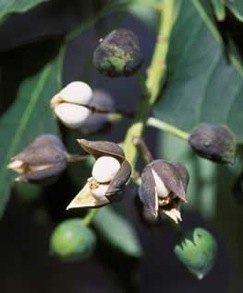
Has toxic seed oil.
Is it edible? Yes, no, maybe… The Chinese Tallow tree is both banned and championed. It’s edibility is also linked to why it’s even in the United States to begin with. The tree was imported by none other than Ben Franklin (well… he sent some seeds to a friend.) The purpose was to use the white external seed fat for making candles which beef suet, tallow, was once used for. Hence the tree’s name in English. In theory that small coating of saturated fat on the outside of the seed is edible. It is also very stable. But there are two problems. It can be very difficult to remove and inside the seed there is an oil toxic to humans. So the fat and the oil should not mix. Some people have experimented with crushing the entire seed and heating the mash thus melting the saturated fat along with releasing the toxic oil. When they settle the edible fat and the non-edible oil are separated. In China, where the tree is valued, they steam the white saturated fat off. The tree, while an invasive species in some areas of North America — such as Florida — is being considered as a good candidate for bio-fuel. You can read my article about it here about it here. A later magazine article about the species is here.
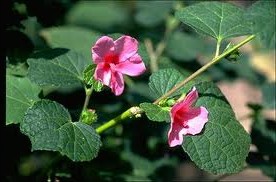
Caesarweed is in the hibiscus group.
Caesarweed is a common sight locally but right now it is being a seasonal extrovert and blossoming profusely. Like the Chinese Tallow tree above, Caesar Weed is another plant intentionally imported for industrial use, in its case making fiber for burlap bags and the like. It’s not strong enough to make a sturdy rope like Skunk Vine (which is also blossoming now and was imported to make rope.) But if thrown in water and allowed to rot for a few weeks long blast fibers are left over. The tasteless flowers are edible, the seeds can be ground and used like corn starch, and the leaves have medicinal uses besides being a famine food. Young sprouts are edible raw. Mature leaves are hairy and upset the tummy. You can read about Caesar Weed here or see a video I did on it here.
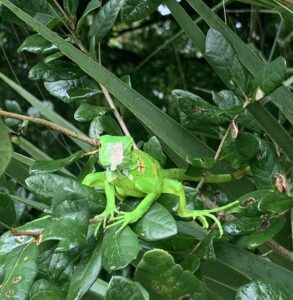
Young iguana: photo by Green Deane
Seen but not tasted in West Palm Beach were iguanas. This little one watched us as we looked at some deadly Rosary Pea. Iguanas are quite edible and there are several way to capture them. One is to wait for cold weather, they will fall out of trees in front of you. Just don’t do what one hungry fellow did a couple of winters ago. He collected several cold adult iguanas and put them in his car. As he drove home the heat in the car warmed them into defensive activity. To read more about them my article, Ignite of the the Iguana is here.

You get the USB, not the key.
150-video USB would be a good end of spring present and is now $99. My nine-DVD set of 135 videos has been phased out. The USB videos are the same videos I have on You Tube. Some people like to have their own copy. The USB videos have to be copied to your computer to play. If you want to order the USB go to the DVD/USB order button on the top right of this page. That will take you to an order form. I’d like to thank all of you who ordered the DVD set over the years which required me to burn over 5,000 DVDs individually.

Green Deane Forum
Want to identify a plant? Perhaps you’re looking for a foraging reference? You might have a UFO, an Unidentified Flowering Object, you want identified. On the Green Deane Forum we — including Green Deane and others from around the world — chat about foraging all year. And it’s not just about warm-weather plants or just North American flora. Many nations share common weeds so there’s a lot to talk. There’s also more than weeds. The reference section has information for foraging around the world. There are also articles on food preservation, and forgotten skills from making bows to fermenting food.
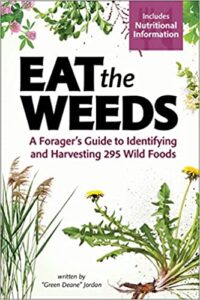 Now being printed is EatTheWeeds, the book. It should have 275 plants, 350-plus pages, index and color photos. Several hundred have been preordered on Amazon. And it is being printed now. Most of the entries include a nutritional profile. Officially it will be published December 5th (to suit the publisher publicity demands) and apparently to appeal to the winter market.
Now being printed is EatTheWeeds, the book. It should have 275 plants, 350-plus pages, index and color photos. Several hundred have been preordered on Amazon. And it is being printed now. Most of the entries include a nutritional profile. Officially it will be published December 5th (to suit the publisher publicity demands) and apparently to appeal to the winter market.
This is weekly newsletter #576. If you want to subscribe to this free newsletter you can find the sign-up form in the menu at the top of the page.
To donate to the Green Deane Newsletter click here.

